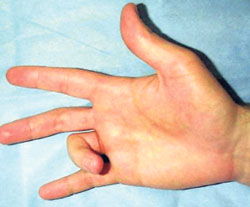A trigger finger is a finger that becomes 'locked' after it has been bent (flexed). It is difficult to straighten out without pulling on it with the other hand. You may hear a 'click' when it is pulled straight. One or more fingers may be affected. Sometimes there is mild pain and/or a small swelling at the base of the affected finger.
What causes it?
The cause is often not clear. It is thought to be due to some inflammation which causes swelling of a tendon or tendon sheath.
- A tendon is a strong tissue that attaches a muscle to a bone. In this case the tendon comes from a muscle in the forearm. It passes through the palm and attaches to the finger bone. The muscle pulling on this tendon bends (flexes) the finger towards the palm.
- A tendon sheath is like a tunnel that covers and protects parts of a tendon. Normally, the tendon slides easily in and out of the sheath as you bend and straighten the finger. In trigger finger the tendon can slide out of the sheath when you bend your finger. However, it cannot easily slide back in due to the swelling. The finger then remains bent (flexed) unless you pull it straight with your other hand.
Most cases occur for no apparent reason in healthy people. In some cases it occurs after you have used your palm a lot. For example, after jobs which involve the use of a screwdriver or other tools that press on the palm. These may cause some inflammation in the palm.
 |
| Trigger Ring finger |
Sometimes trigger finger occurs as a feature of another disease. For example, trigger finger is more common in people with rheumatoid arthritis, amyloidosis, diabetes, carpal tunnel syndrome, and in people on dialysis. In these situations you will have other symptoms of the condition and the trigger finger is just one feature. And it has to be stressed that, most people with trigger finger do not have any of these conditions.
What is the treatment ?
Not treating is an option at first.
Simply resting the hand and allowing any inflammation to settle may resolve the problem without the need for treatment.
A steroid injection into the tendon sheath is the usual treatment if the condition does not settle. The steroid is combined with a local anaesthetic to make the injection painless. Steroids work by reducing inflammation. A finger splint may be advised for a few days after the injection to rest the finger. This treatment works in about 9 in 10 cases. A second injection may be needed if the first does not work.
An operation done under local anaesthetic may be advised if the above does not work. A small cut is made at the base of the finger and the tendon sheath is widened. The operation is usually successful. However, with this operation there is a small risk of damaging the tiny finger nerve, and causing some numbness to the finger. Also, as with any operation, there is a small risk of the wound becoming infected.
(The writer is a Consultant Rheumatologist at the Sri Jayewardenepura General Hospital)
|

